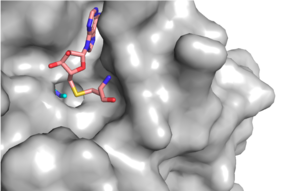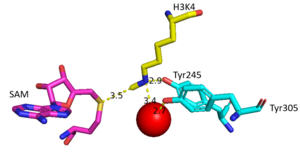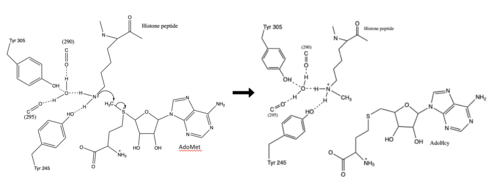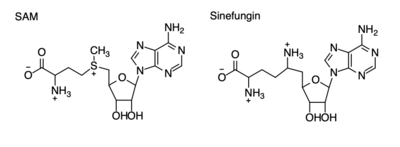User:Ashley Crotteau/Sandbox1
From Proteopedia
(Difference between revisions)
| Line 16: | Line 16: | ||
The ΔSET7/9 consists of the SET domain along with the pre- and post-SET regions.<ref name="Schubert" /><ref name="Yeates" /> The pre- and post-SET regions are adjacent to SET domain and are cysteine rich.<ref name="Schubert" /><ref name="Yeates" /> The pre-SET cysteine region is located near the N-terminal where the post-SET region is located near the C-terminal of the domain.<ref name="Schubert" /><ref name="Yeates" /> These regions are said to play an important role in substrate recognition and enzymatic activity.<ref name="Schubert" /><ref name="Yeates" /> The cysteine regions are not shown in the crystal structure as only residues 117-366 were crystalized.<ref name="Xiao" /> | The ΔSET7/9 consists of the SET domain along with the pre- and post-SET regions.<ref name="Schubert" /><ref name="Yeates" /> The pre- and post-SET regions are adjacent to SET domain and are cysteine rich.<ref name="Schubert" /><ref name="Yeates" /> The pre-SET cysteine region is located near the N-terminal where the post-SET region is located near the C-terminal of the domain.<ref name="Schubert" /><ref name="Yeates" /> These regions are said to play an important role in substrate recognition and enzymatic activity.<ref name="Schubert" /><ref name="Yeates" /> The cysteine regions are not shown in the crystal structure as only residues 117-366 were crystalized.<ref name="Xiao" /> | ||
| - | The SET domain is mostly defined by <scene name='81/811707/Variable_knot/2'>turns and loops</scene> with the few <scene name='81/811707/Beta_sheets/3'>antiparallel β-sheets</scene>.<ref name="Schubert" /> <scene name='81/811707/Beta-hairpin/3'>Residues 337-349</scene> form a β-hairpin that sticks out at a right angle to the surface of the enzyme.<ref name="Xiao" /> The following three residues (<scene name='81/811707/Sharp_bend/3'>350-352</scene>) accommodate a sharp bend in the peptide chain and the end of the protein adopts an <scene name='81/811707/C-term_alpha_helix/2'>α-helical conformation</scene>.<ref name="Xiao" /> The two most defining features of the SET domain are the C-terminal tyrosine and the knot-like fold. These two components have been recognized to be essential for S-adenosyl-L-methionine(SAM) binding and catalysis, which is shown as <scene name='81/811707/Sam_isolated/2'>S-adenosyl-L-homocysteine</scene> in the structure after methylation of the histone.<ref name="Schubert" /> <ref name="Yeates" /> <ref name="Huang" /> The knot-like fold contains the binding sites for the cofactor SAM and the peptide substrate.<ref name="Licciardello" /> | + | The SET domain is mostly defined by <scene name='81/811707/Variable_knot/2'>turns and loops</scene> with the few <scene name='81/811707/Beta_sheets/3'>antiparallel β-sheets</scene>.<ref name="Schubert" /> <scene name='81/811707/Beta-hairpin/3'>Residues 337-349</scene> form a β-hairpin that sticks out at a right angle to the surface of the enzyme.<ref name="Xiao" /> The following three residues (<scene name='81/811707/Sharp_bend/3'>350-352</scene>) accommodate a sharp bend in the peptide chain and the end of the protein adopts an <scene name='81/811707/C-term_alpha_helix/2'>α-helical conformation</scene>.<ref name="Xiao" /> The two most defining features of the SET domain are the C-terminal tyrosine and the knot-like fold. These two components have been recognized to be essential for S-adenosyl-L-methionine(SAM) binding and catalysis, which is shown as <scene name='81/811707/Sam_isolated/2'>S-adenosyl-L-homocysteine</scene>(SAH) in the structure after methylation of the histone.<ref name="Schubert" /> <ref name="Yeates" /> <ref name="Huang" /> The knot-like fold contains the binding sites for the cofactor SAM and the peptide substrate.<ref name="Licciardello" /> |
[[Image:KMT_Channel.png|300 px|right|thumb|Figure 1: Narrow Lysine Channel]] | [[Image:KMT_Channel.png|300 px|right|thumb|Figure 1: Narrow Lysine Channel]] | ||
| Line 22: | Line 22: | ||
| - | The most notable feature of the HKMT is the presence of the lysine access channel as the active site. The cofactor and <scene name='81/811708/Sam_structure/3'>peptide</scene> substrate are | + | The most notable feature of the HKMT is the presence of the lysine access channel as the active site. The cofactor and <scene name='81/811708/Sam_structure/3'>peptide</scene> substrate are located on opposite sides of the SET domain but are connected through this narrow channel (Figure 1).<ref name="Xiao" /> This channel allows these two components to interact and complete the methyltransfer. The active site in general is considerably tyrosine rich. Residues Tyr245, His297, Ser268, Tyr305, Tyr335, and Tyr337 all help to shape the <scene name='81/811707/Stick_active_site/2'>active site</scene> and the channel.<ref name="Xiao" /> The cofactor involved, SAM, provides the methyl for methylation of the lysine on its sulfur atom. |
[[Image:Water.PNG|300 px|right|thumb|Figure 2: Water being utilized in the active site]] | [[Image:Water.PNG|300 px|right|thumb|Figure 2: Water being utilized in the active site]] | ||
| - | The beta hairpin stabilizes the <scene name='81/811707/Beta_hairpin_stabilizing_tyrs/1'>conformation of Tyr335 and Tyr337</scene>, while also shaping one side of the channel which the peptide binds to.<ref name="Xiao" /> The <scene name='81/811707/Peptide_binding_site/1'>peptide binding groove</scene> is composed of residues 255-268.<ref name="Xiao" /> Lysine would have trouble coming down into the active site in its charged form, but it is facilitated by the faces of the flanking tyrosines.<ref name="Xiao" /> The orientation of the lysine is such that the amine-methyl bond is aligned towards the sulfur on SAM so that it can provide the methyl. There is an important water in the active site (Figure 2) | + | The beta hairpin stabilizes the <scene name='81/811707/Beta_hairpin_stabilizing_tyrs/1'>conformation of Tyr335 and Tyr337</scene>, while also shaping one side of the channel which the peptide binds to.<ref name="Xiao" /> The <scene name='81/811707/Peptide_binding_site/1'>peptide binding groove</scene> is composed of residues 255-268.<ref name="Xiao" /> Lysine would have trouble coming down into the active site in its charged form, but it is facilitated by the faces of the flanking tyrosines.<ref name="Xiao" /> The orientation of the lysine is such that the amine-methyl bond is aligned towards the sulfur on SAM so that it can provide the methyl. There is an important water in the active site (Figure 2) that accepts a hydrogen bond from the lysine substrate, shifting the lone pair on the nitrogen towards the sulfur of SAM. <ref name="Xiao" /> |
| Line 33: | Line 33: | ||
[[Image:KMT Mechanism .png|500 px|right|thumb|Figure 3: Histone Methylation by HKMT Mechanism]] | [[Image:KMT Mechanism .png|500 px|right|thumb|Figure 3: Histone Methylation by HKMT Mechanism]] | ||
| - | The N from the lysine serves as a nucleophile that attacks the electrophilic CH<sub>3</sub> that is present in the AdoMet. The sulfur that the CH<sub>3</sub> is attached to pulls the electrons towards itself to weaken the bond between the sulfur and the carbon. This weak bond allows for the N to break that bond and take the methyl group. The N on the lysine is being stabilized by Tyr residues and a water molecule (Figure 3). This allows the N to | + | The N of the amine from the lysine serves as a nucleophile that attacks the electrophilic CH<sub>3</sub> that is present in the AdoMet (SAM). The sulfur that the CH<sub>3</sub> is attached to pulls the electrons towards itself to weaken the bond between the sulfur and the carbon. This weak bond allows for the N to break that bond and take the methyl group. The N on the lysine is being stabilized by Tyr residues and a water molecule (Figure 3). This allows the N to accept the methyl and take up that positive charge. |
| - | The conserved regions of KMT | + | The tyrosine conserved regions of KMT have been found to be vital for only monomethylation. Multiple studies have found that a mutation to any of the conserved tyrosine residues does still monomethylate SAM, but it also creates di-methylation and tri- methylation of SAM.<ref name="Del Rizzo" /> In a recent study, Y245A and Y305F were created through site-directed mutagenesis.<ref name="Del Rizzo" /> Due to size, Ala245 was found to create a larger opening of the channel than tyrosine, which allowed for further methylation of SAM. <ref name="Del Rizzo" /> However, Y305F also showed the same characteristics of di- and tri-methylation, most likely due to a decrease of tyrosine residue interaction with water.<ref name="Del Rizzo" /> As there are four invariant conserved tyrosine residues (Tyr305, Tyr245, Tyr335, Tyr337) in the active site, this finding indicates that the function of KMT is dependent on the presence of tyrosine residues in the active site. <ref name="Del Rizzo" /> |
== Relevance == | == Relevance == | ||
Revision as of 18:51, 24 April 2019
H. sapiens Lysine Methyltransferase, SET 7/9
| |||||||||||
References
[3] [8] [5] [6] [7] [9] [10] [11] [1] [2] [4]
- ↑ 1.0 1.1 DesJarlais R, Tummino PJ. Role of Histone-Modifying Enzymes and Their Complexes in Regulation of Chromatin Biology. Biochemistry. 2016 Mar 22;55(11):1584-99. doi: 10.1021/acs.biochem.5b01210. Epub , 2016 Jan 26. PMID:26745824 doi:http://dx.doi.org/10.1021/acs.biochem.5b01210
- ↑ 2.0 2.1 Marino-Ramirez L, Kann MG, Shoemaker BA, Landsman D. Histone structure and nucleosome stability. Expert Rev Proteomics. 2005 Oct;2(5):719-29. PMID:16209651 doi:http://dx.doi.org/10.1586/14789450.2.5.719
- ↑ 3.00 3.01 3.02 3.03 3.04 3.05 3.06 3.07 3.08 3.09 3.10 Xiao B, Jing C, Wilson JR, Walker PA, Vasisht N, Kelly G, Howell S, Taylor IA, Blackburn GM, Gamblin SJ. Structure and catalytic mechanism of the human histone methyltransferase SET7/9. Nature. 2003 Feb 6;421(6923):652-6. Epub 2003 Jan 22. PMID:12540855 doi:10.1038/nature01378
- ↑ 4.0 4.1 4.2 doi: https://dx.doi.org/10.15406/mojcsr.2016.03.00047
- ↑ 5.0 5.1 5.2 5.3 5.4 5.5 5.6 Schubert HL, Blumenthal RM, Cheng X. Many paths to methyltransfer: a chronicle of convergence. Trends Biochem Sci. 2003 Jun;28(6):329-35. PMID:12826405
- ↑ 6.0 6.1 6.2 6.3 6.4 6.5 Yeates TO. Structures of SET domain proteins: protein lysine methyltransferases make their mark. Cell. 2002 Oct 4;111(1):5-7. PMID:12372294
- ↑ 7.0 7.1 Huang S, Shao G, Liu L. The PR domain of the Rb-binding zinc finger protein RIZ1 is a protein binding interface and is related to the SET domain functioning in chromatin-mediated gene expression. J Biol Chem. 1998 Jun 26;273(26):15933-9. PMID:9632640
- ↑ 8.0 8.1 doi: https://dx.doi.org/10.1016/C2014-0-02189-2
- ↑ 9.0 9.1 9.2 9.3 9.4 9.5 Del Rizzo PA, Couture JF, Dirk LM, Strunk BS, Roiko MS, Brunzelle JS, Houtz RL, Trievel RC. SET7/9 catalytic mutants reveal the role of active site water molecules in lysine multiple methylation. J Biol Chem. 2010 Oct 8;285(41):31849-58. Epub 2010 Aug 1. PMID:20675860 doi:http://dx.doi.org/10.1074/jbc.M110.114587
- ↑ 10.0 10.1 10.2 10.3 10.4 Sun G, Reddy MA, Yuan H, Lanting L, Kato M, Natarajan R. Epigenetic histone methylation modulates fibrotic gene expression. J Am Soc Nephrol. 2010 Dec;21(12):2069-80. doi: 10.1681/ASN.2010060633. Epub 2010, Oct 7. PMID:20930066 doi:http://dx.doi.org/10.1681/ASN.2010060633
- ↑ 11.0 11.1 Tian X, Zhang S, Liu HM, Zhang YB, Blair CA, Mercola D, Sassone-Corsi P, Zi X. Histone lysine-specific methyltransferases and demethylases in carcinogenesis: new targets for cancer therapy and prevention. Curr Cancer Drug Targets. 2013 Jun;13(5):558-79. doi:, 10.2174/1568009611313050007. PMID:23713993 doi:http://dx.doi.org/10.2174/1568009611313050007
Student Contributors
Ashley Crotteau
Parker Hiday
Lauren Allman




